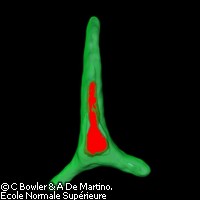Genome of carbon-capturing marine algae sequenced
A study led by researchers in France and the US has sequenced the genome of the diatom Phaeodactylum tricornutum, a kind of microscopic algae that thrives in oceans and captures atmospheric carbon. Diatoms are essential components of oceanic carbon sinks, and produce approximately 20% of the oxygen we breathe. This study has contributed greatly to our understanding of how they work. The findings, which are published online by the journal Nature, came out of an international collaboration funded in part by the EU's Sixth Framework Programme (FP6). Diatoms are photosynthetic organisms that live in marine and freshwater environments. They have been around for approximately 180 million years, and hundreds of thousands of diatom species exist today. The study compared the genome sequence of Phaeodactylum tricornutum, which can be grown easily in a laboratory, with that of another recently sequenced diatom. The structures of the two diatoms were found to be dramatically different: 40% of their genes were not shared. Interestingly, the researchers found that hundreds of genes from bacteria were present in the genomes of both diatom species. The bacterial genes found in diatoms could contribute to their success, enhancing their ability to perceive environmental signals or to metabolise organic carbon and nitrogen. Some of these bacterial genes might be responsible for certain cell-wall components in diatoms, and others for 'unorthodox mechanisms of DNA replication, repair and recombination'. According to the study, 'these findings go a long way towards explaining the incredible diversity and success of the diatoms in contemporary oceans'. First author Chris Bowler of the Ecole Normale Supérieure in France explained, 'These organisms represent a veritable melting pot of traits: a hybrid of genetic mechanisms contributed by ancestral lineages of plants, animals, and bacteria, and optimised over the relatively short evolutionary timeframe of 180 million years since they first appeared.' The study showed that gene transfer between diatoms and other organisms has been extremely common in marine environments, making diatoms 'transgenic by nature'. For example, the diatom inherited its photosynthetic capacity from plants, and its ability to process urea from animals (although unlike animals, diatoms use urea to store, not eliminate, nitrogen). The researchers propose that this gene transfer has been a major driving force during diatom evolution. A central question is whether carbon-capturing organisms can cope with environmental change. The discovery of the diatom's selective acquisition of genetic material from other organisms goes a long way in improving our understanding of the dramatic and rapid diversification of diatoms, but much remains to be learned. The team will focus next on the role of iron in the suppression of photosynthesis and nitrogen assimilation. Dr Bowler proposed that because diatoms capture carbon dioxide so efficiently, and because iron is so precious in marine environments, one strategy might be to use iron to provoke massive diatom blooms. 'Once they have feasted,' he explained, 'the weight of their silicon shells, which resemble glass, causes the diatoms to sink to the bottom of the ocean when they die, and the carbon that they assimilated is trapped there for millennia. 'By sequestering carbon in this way we could reverse the damage from the burning of fossil fuels,' he said. The collaboration included partners from 10 countries and was funded in part by the EU-funded DIATOMICS and Marine Genomics projects.



